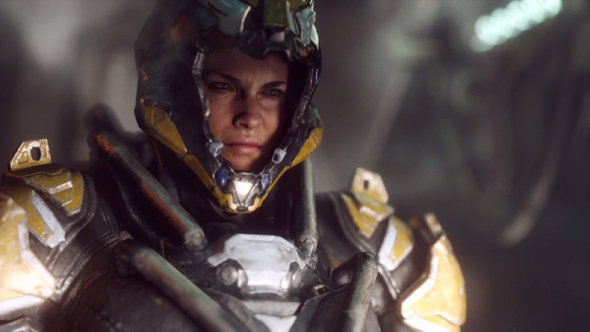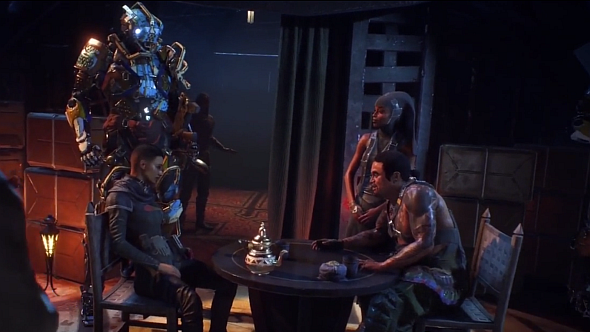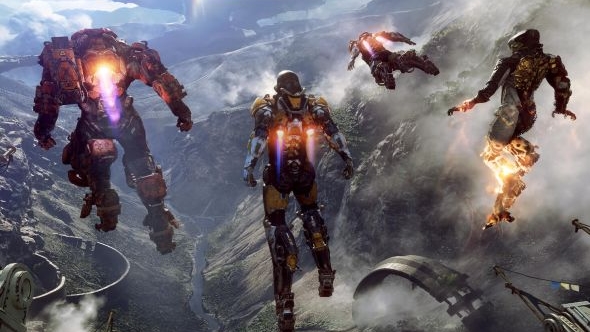Anthem isn’t the first non-RPG BioWare has made. It’s not even the company’s first shooter. But it is sufficiently different from the developer’s stock in trade that it’s suffering a bit of a backlash – particularly in the wake of E3’s revelations.
As it turns out, most of the game’s customisation is reserved for its exosuits, not your character. Conversation and dialogue choices will be mostly absent from the game’s missions. And there will be no RPG-style companions to accompany you, at least not at the game’s launch, which removes the potential for smooching with NPCs. This latter point in particular has upset a faction which, if they were labelled in a codex, would probably be called the Garrus Stans.
In the past, BioWare have produced some of the best RPGs on PC.
“Oh ffs,” one tweeted shortly after EA Play’s Anthem reveal. “Why even bother calling it a Bioware game at all then?”
“Because BioWare is making it,” executive producer Mark Darrah answered.
It’s a pithy reply. But what if, instead of just retweeting, we took it as an invitation to dig into the BioWare-ness of Anthem?
To study the available information on this co-op shooter and identify the common links with the studio’s history? Yes, let’s do that.
Swordplay and sanctuary

BioWare has deep roots in Dungeons & Dragons. Yes, Shattered Steel and MDK 2 form a part of the studio’s early history, but the BioWare we know today began with Baldur’s Gate, the acclaimed isometric RPG that stuck close to its Forgotten Realms setting. Some of the series’ most famous characters, including Minsc and Boo, were born from the studio’s tabletop D&D sessions.
The upshot of that is that BioWare inherited its structure and pacing from D&D: in particular, the dichotomy of town and dungeon. In BioWare games, even today, you receive your quest in a city or hamlet, leave civilisation to delve into a dangerous place that may or may not be underground, then return to the light to pawn your gear and attend to your wounds.
For Anthem, Bioware have defined those two spaces more rigidly than ever before. Inspired no doubt by Destiny’s Last City, Anthem restricts its downtime to a peaceful hub area. While in the shantytown-like Fort Tarsis, you’ll interact with the locals, build friendships, and make significant choices in the game’s branching story. This is the only part of the game that’s single-player.
Your adventures out in the wilds are co-op, action-focused, and send you deep into tropical rainforest environments – the ones we’ve seen in the trailers, cast into shadow by giant trees and rock formations. The juxtaposition of Anthem’s two parts is only solidified by its lore, which puts Tarsis behind a literal wall that protects humanity from the storms, and leaves the monsters out in the open world.
It’s fantasy, not sci-fi

Bioware is a studio of fantasy nerds. In its many years of developing RPGs, it has always chosen to escape into new worlds rather than explore our own. The developer’s brief dance with Chinese culture, Jade Empire, drew more from mythology than history. Even its one attempt at a contemporary, real-world story – the cancelled Shadow Realms – was coloured by crossover with a fantasy land of magical relics and towering castles.
Anthem fits that tradition. Despite its focus on super-advanced technology and the trials of humanity, it has left Earth for a genre Bioware calls “science fantasy”.
“Very much like Star Wars or the Marvel Universe,” general manager Aaryn Flynn has said, “where you see a lot of amazing things happening but we don’t worry too much about why they’re happening or how they’re happening, the science of it.”
In a way, Anthem is less of a leap than Mass Effect’s sci-fi. This is still a world of wizards and warriors, simply hand-waved in a different way. The ancient and abandoned Shaper technology that provides the impetus for Anthem’s action is so old and advanced that it’s indistinguishable, you might say, from magic.
You play in a party

Traditionally, one of Bioware’s great strengths over its contemporaries lay in combat design. In other RPGs from the turn of the millennium, fighting often meant a boring slog to rid the screen of mobs. But by Throne of Bhaal, Baldur’s Gate II’s concluding chapter, Bioware battles were beautiful, choreographed dances of devious enemy placement.
While prevailing game design philosophy tends to suggest that the fun of a fight should emerge dynamically, Bioware was unafraid to script its battles – to the point that you could reload and try a specific counter to a painful spell. They became puzzles to solve.
The same approach ran through Dragon Age: Origins, but was lost in the Mass Effect series, which was understandably focused on being a satisfying shooter with a single controllable character.
Anthem, by contrast, is made for co-op – which effectively means you’re playing with a party. Each member covers the others’ weaknesses. The Colossus is big and heavy enough to take the brunt of an explosive trap for your team. In the E3 demo, we see a more agile Javelin freeze enemies solid with an AOE attack, so that the Colossus can take advantage of their stasis and rain down artillery fire. As each missile lands, the word ‘COMBO’ pops up – which tells us the game recognises and rewards the same tactical nouse Baldur’s Gate asked for. It’s worth noting that Anthem spent a long time in pre-production at the original Bioware studio in Edmonton.
Oh, and your choice of Javelin before a mission? That’s flicking through your spellbook to see which abilities will best serve you for the next fight. Only this time, the nap before battle is optional.
